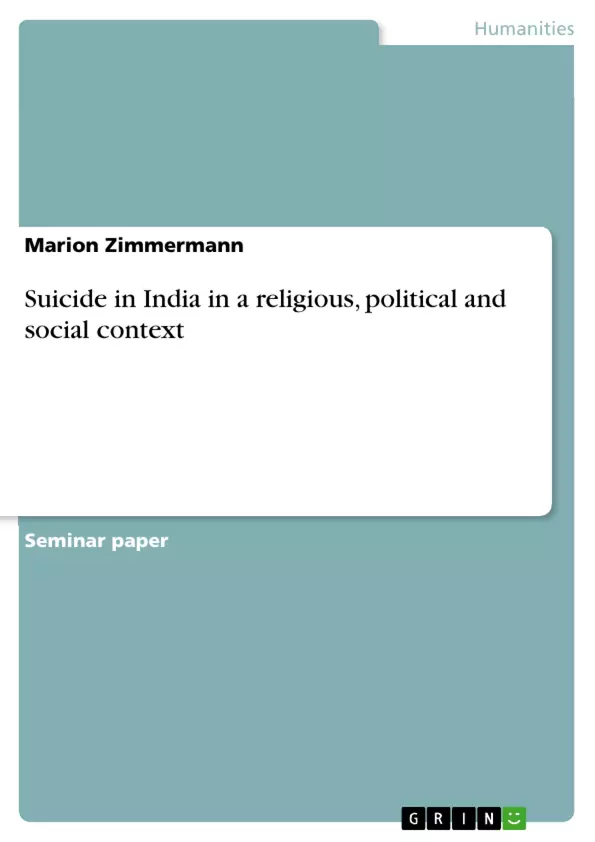Suicide is the intentional destruction of one´s own life. The most people who commit suicide do it with the hope for rescue, because in reality they don’t want die. This self-destroying act is rather a cry for help and a desperate attempt to change hopeless situtations. Only less of all suicides happen deliberate without chance for help. In general men use harder methods to kill themselves than women, e.g. very often men shoot or hang themselves and women use more likely an overdose of sleeping pills (Digel, Werner (Hg.), Kwiatkowski, Gerhart (Hg.) 1987: 96). This informations would stand for that men are more determined to die definite than women who more likely hope for rescue. Indeed the rate of suicide committed by men is in the most countries in general higher than that of women (www : WHO 2001 b).
The general causes of suicide and high- risk groups are mostly aged people, divorced, unemployed, social isolated, addict (especially alcoholics), psychically unbalanced and those who already attempted suicide in the past. Problems of women are often lovesickness, marital and family conflicts, problems of men are economic and social (especially professional) difficulties. The best prevention against suicides is the support of social relationships and organizations, which should be accessible for all people who need help (Digel, Werner (Hg.), Kwiatkowski, Gerhart (Hg.) 1987: 96).
In the following chapters I descibe different kind of suicide in India. After general informations about suicide, I explain suicide in the context of religion, politic and society. Therefore I make following categories: a) religious suicide, b) political suicide, and c) social suicide. The chapter about social suicide is more detailed. Social suicide is seen as a public health problem. Positive changes can be achieved through prevention and care programs which I deal with at the end of this essay. I will not make a detailed comparing between India and other countries. I make no specific separation or detailed comparing between different groups, like young-old, men-women, different castes, different social strata, etc.
My informations are hold very general.
Inhaltsverzeichnis (Table of Contents)
- Introduction
- The legal consideration of suicide
- Statistics about suicide
- Suicide, homicide or accident? The unrecorded and untrue recorded cases
- Religious suicide
- Political suicide
- Social suicide
- Causes for social suicide
- Methods of suicide
- Suicide Prevention
- Conclusion
Zielsetzung und Themenschwerpunkte (Objectives and Key Themes)
This essay aims to explore the phenomenon of suicide in India, examining its occurrence within religious, political, and social contexts. It seeks to understand the underlying causes and motivations behind suicide, as well as the cultural and legal factors that influence its prevalence.
- The legal considerations surrounding suicide in India
- The prevalence of suicide in India and its changing trends
- The role of religion in suicide, including historical practices and contemporary beliefs
- The impact of political and social factors on suicide rates
- The importance of suicide prevention programs and the need for a more nuanced understanding of the issue
Zusammenfassung der Kapitel (Chapter Summaries)
- Introduction: Provides an overview of suicide, including its definition, common motivations, and methods. It also introduces the focus of the essay on the different types of suicide in India.
- The legal consideration of suicide: Discusses the legal framework surrounding suicide in India, highlighting its illegality and the societal consequences for individuals and families.
- Statistics about suicide: Examines suicide statistics in India and globally, providing insights into trends and potential contributing factors.
- Suicide, homicide or accident? The unrecorded and untrue recorded cases: Investigates the complexities of reporting suicide cases in India, exploring how social and legal pressures can lead to misclassification and underreporting.
- Religious suicide: Delves into the historical and contemporary role of religion in suicide, exploring practices and beliefs that may influence its occurrence.
- Political suicide: Analyzes the potential relationship between political factors and suicide rates, considering the impact of societal structures and political ideologies.
- Social suicide: Offers an in-depth examination of the social causes, methods, and prevention strategies for suicide. This chapter discusses the impact of socioeconomic factors, cultural norms, and personal struggles on individual choices.
Schlüsselwörter (Keywords)
This essay focuses on key concepts such as suicide, religion, politics, society, culture, legal framework, statistics, social pressures, and prevention programs in the context of India. It explores the complex interplay of these elements in shaping the prevalence and understanding of suicide within the Indian context.
- Quote paper
- Marion Zimmermann (Author), 2002, Suicide in India in a religious, political and social context, Munich, GRIN Verlag, https://www.grin.com/document/80758



